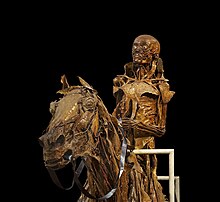Honoré Fragonard
Honoré Fragonard (born June 13, 1732 in Grasse , † April 5, 1799 in Charenton-le-Pont ) was a French anatomist and first director of the veterinary school École vétérinaire d'Alfort, opened in 1766 . His écorchés , anatomical specimens in which the internal organs and skeleton are preserved by removing the skin, are the most important exhibits in the Musée Fragonard, a museum of medical history .
biography
Honoré Fragonard, a cousin of the painter Jean-Honoré Fragonard , was born in 1732 in Grasse in the south of France . Fragonard was the son of a perfumer and glove maker, but underwent training as a surgeon , which he completed in 1759. In 1762 he found a job as an anatomy professor at the veterinary school founded by Claude Bourgelat in Lyon. There he began to make anatomical specimens . In 1765 he went to Paris with some students at the instigation of Bourgelat to set up another veterinary school. This established itself as École vétérinaire in 1766 in Alfort , Fragonard became its first director. In his function as anatomy professor, he oversaw the Cabinet du Roi , the anatomical collection, and expanded it with many objects he had made himself. In 1771, after violent differences with Bourgelat, who oversaw the school, he was dismissed.
Fragonard continued his work as an anatomist and sold his preparations with some success. He took an active part in the French Revolution and, as an expression of the high esteem that medicine enjoyed, he had a seat on the national art jury in 1793 alongside his cousin Jean-Honoré Fragonard and Jacques-Louis David . In 1794 he took over the inventory of the French anatomy collections, which also included the former Cabinet du Roi of the veterinary school in Alfort. He did not succeed in uniting them in a national institution. In 1795, Fragonard took up the post of director of the anatomical department at the École de Santé, newly founded in 1794, as the last little documented activity before his death .
Fragonard's Écorchés

The anatomical specimens that established Fragonard's reputation were his écorchés . The internal organs and the skeleton of human or animal bodies or body parts were preserved by removing the skin. Fragonard did not document the technique he used. According to scientific studies carried out after 2003, it corresponded to that which his contemporary Jean-Joseph Sue (1710–1792) in his treatise Anthropotomie ou l'Art de disséquer, d'embaumer et de conserver les parties du corps humain (“ Anthropotomy or the art of dissecting, embalming and preserving human body parts ”, Paris 1750). The corpse was heated in seven steps, the blood replaced with a special liquid made from sheep fat, pine resin, turpentine and essential oils and the body or parts of the body, after they were brought into the desired position, a procedure of soaking in alcohol and subsequent drying in order to be colored lifelike at the end and to receive a varnish made of Venetian turpentine as protection against insect infestation.
Of the estimated 700 Écorchés, 21 still exist, almost all of which are in the Musée Fragonard , a museum of medical history . In the preparations used as scientific demonstration objects, the philosophical current of vitalism can be recognized, for example in the emphasis on blood vessels and nerve cords. Some preparations, in the design of which apparently more emphasis was placed on the artistic and emotional effect, are in the tradition of the Kunstkammer objects and are biblically or allegorically charged , for example with the vanitas motif . This is particularly the case with a rider on a galloping horse, a man with a jaw in his hand depicting Samson, and with fetuses that were prepared in movement or dance poses and, according to traditional descriptions, were arranged as a group. According to a legend, the equestrian figure is Fragonard's fiancée, who died before the wedding and which he is said to have prepared himself. In fact, it is the preserved corpse of a man, as can be seen from the remains of a penis.
bibliography
- Christophe Degueurce: Honoré Fragonard et ses Écorchés. Un anatomist au siècle des Lumières . Ed. RMN, Paris 2010, ISBN 978-2-7118-5748-7
Web links
- Musée Fragonard: Honoré Fragonard (1732-1799)
- Art et Science: Ces expositions anatomiques qui fascinent et qui dérangent. Honoré Fragonard et ses écorchés
- Neue Zürcher Zeitung , February 22, 2003: Stagnant blood. Honoré Fragonard as anatomist and «scientific artist»
- Joan B. Landes: Wax fibers, wax bodies and moving figures. In: Roberta Panzanelli: Ephemeral bodies: wax sculpture and the human figure. Getty Publications, Los Angeles 2008, pp. 41-66
- Philippe Raxhon: Honoré Fragonard: un anatomist témoin de son siècle
proof
- ↑ WG Sebald: Austerlitz . Carl Hanser Verlag , Munich and Vienna 2001, pp. 374–376, ISBN 3-446-19986-1
- ↑ Frederik Ruysch (1638–1731) had already produced comparable Vanitas dioramas with fetal skeletons. ( Zymoglyphic Museum: Frederik Ruysch's Anatomical Dioramas .)
- ↑ Musée Fragonard: La légende de la fiancée de Fragonard ("L'examen attentif de la pièce révèle cependant un reste de pénis ligaturé qui ne laisse aucun doute sur le sexe du cavalier." - "However, the careful examination of the object reveals the rest a tied penis that leaves no doubt about the rider's sex. ")
| personal data | |
|---|---|
| SURNAME | Fragonard, Honoré |
| BRIEF DESCRIPTION | French anatomist |
| DATE OF BIRTH | June 13, 1732 |
| PLACE OF BIRTH | Grasse |
| DATE OF DEATH | April 5, 1799 |
| Place of death | Charenton-le-Pont |